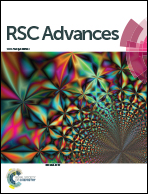The directions of an external electric field control the catalysis of the hydroboration of C–O unsaturated compounds†
Abstract
The orientation directions of an external electric field (EEF) in catalyzing chemical reactions are an important factor because they can significantly accelerate reaction activity. In this study, we explored a new anti-Markovnikov hydroboration reaction of C–O unsaturated compounds (e.g., benzaldehyde and benzophenone) with the aim of revealing the dominant direction of EEF in accelerating the reactions, and pinacolborane (HBpin) was selected as an efficient reductant. The calculation results showed that the EEF oriented along the direction of electron pair transform rather than that of the molecular dipole moment could reduce the barrier of the hydroboration of benzaldehyde by 20 kcal mol−1 when the EEF was up to 150 × 10−4 au. Moreover, the Markovnikov hydroboration of aldehyde and ketone was investigated for obtaining the mechanistic-switchover point. Unsatisfactorily, the EEF could just influence the respective barriers without a promising competition with the anti-Markovnikov hydroboration reactions.



 Please wait while we load your content...
Please wait while we load your content...